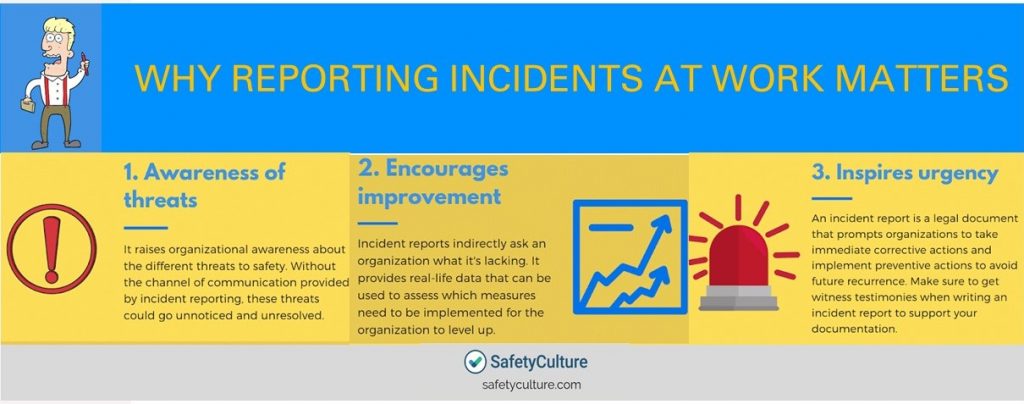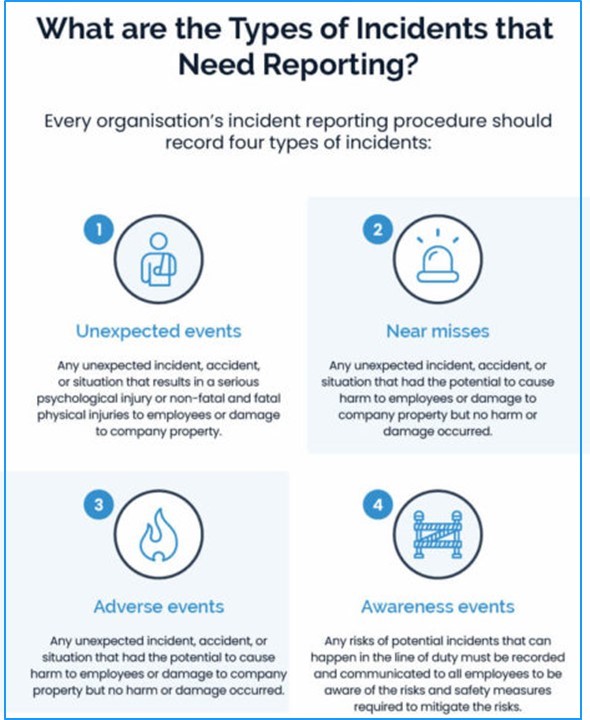10.2 Incident and Inspection Reports
Incident and inspection reports are used routinely in technical workplaces to respond to occurrences or report observations that may have an impact on decision-making and safety. More specifically, incident reports are used to report on unusual occurrences or events, such as accidents, thefts, broken or malfunctioning equipment, and human resources issues. Inspection reports, on the other hand, are used to report on observations, such as site conditions, installations, damages, and the like. Accidents and incidents are quite different things (Korney, 2009):
- Occurrence: An occurrence is an unexpected event.
- Incident: An occurrence that may have resulted in some loss (such as damage to equipment).
- Accident: An occurrence that involves humans either directly or indirectly.
With this understanding of terms, you can then determine how to document the events.
Accident and Incident Reports
Accidents and incidents are very specific to place, time, persons, and conditions. It is critical to capture the objective facts regarding the events because they can have serious implications relating to lawsuits, insurance claims, and preventive measures. So while LLMs can assist in capturing information and transforming it into reports, in such cases, only humans can provide the nuanced descriptive detail pertaining, in particular, to the related circumstances. When creating such a report, LLMs can be useful in capturing photos then analysing what it sees in that photo, or even observing and noting activity as it happens as long as the camera is live. LLMs can also create verbal transcripts and create a template or draft that you would then develop further.
What are accident and incident reports? An accident or incident report documents an injury, accident, work stoppage, equipment failure, worker illness, or personal problem.
You might write an accident/incident report for any of the following situations:
- someone was injured at work
- machinery or other equipment malfunctioned or broke
- work stopped for a significant period of time
- an employee complained of harassment, violence, or bullying
- an employee came to work intoxicated
Why are these reports important? Accident and incident reports can be used in insurance claims, workers’ compensation awards, and even lawsuits. When writing such reports, it is important to document events accurately and objectively to avoid attributing blame or identifying causes incorrectly. The stakes are high when writing these reports, so it is important to follow the guidance provided in this unit carefully.

What goes in an accident/incident report? Accident/incident reports document the who, what, where, when, and how of occurrences. They sometimes also identify why something may have occurred when it is possible. Key components of accident/incident reports are the corrective and preventive actions sections. The corrective actions section describes actions that have been taken to restore the situation; the preventive actions section includes suggestions to prevent the occurrence from happening again.
How do I format an accident/incident report? In many companies, accident/incident reports are completed using a prepared form. The form would ask much of the information listed in the below “Checklist for Accident/Incident Reports.” If the company you work for does not have a form, you can either ask an LLM to help you create the form or you can create a form yourself. Either way, you will then be able to use it as a template for such reporting future occurrences. When form style reporting does not seem quite right for the situation, you can document the incident in an incident report–usually formatted as a short memo report.

Checklist for Accident/Incident Reports – Include key details about the incident in your report. Such detail should include the following:
- Date of the event
- Location
- Full names of the people involved
- Names of witnesses
- Events leading up to the accident
- Environmental conditions if applicable (slippery floors, poor lighting, hazardous materials, etc.)
- Description of the task that was being performed at the time of the incident/accident
- Detailed description of the event
- Parts of the body injured (if an injury occurred) and/or parts of equipment damaged
- Description of employee’s response immediately after the event (grabbing an injured arm, running from the room, etc.)
- Extent of damage
- Corrective actions taken: Treatment of injury or course of action taken
- Preventive measures suggested
If you wish to ask an LLM to create a template for a form or an informal report outline, this list above can serve as a good guide for what the form or report outline should include.

Who is the audience of accident/incident reports? Since these reports have legal implications, the writer should consider the audience to be anyone from the people involved in the incident to your manager, insurance agents, investigators, and/or law enforcement to judges.
Other Considerations:
- Witnesses: Unless you are working alone, you should always seek as many perspectives as is reasonable and possible when writing an accident/incident report. Different people may see different things or remember the situation differently.
- Neutral Language: Because these documents may be used in court or in other legal proceedings, use objective language consisting of specific facts and neutral statements instead of impressions or emotional statements.
Examples:
Poor Example (too biased/emotional): John was just doing his job, working hard like he always does, and being a great team player when Mark rammed into him with the forklift like he was some hitman from an action movie.
Good Example (neutral and specific): John Smith was loading boxes on shelf B2 when Mark Peterson backed into him with the forklift at very low speed, causing John to fall backward and hit a stack of boxes.
Poor Example (based on impressions): It just seemed like Gus was always kind of sweet on Tanya, but he was kind of creepy at the same time. He just made everyone feel uncomfortable. He was too touchy-feely.
Good Example (neutral and specific): On March 13, 2014, three employees (Margo Swinton, Barb Gell, and Tom Haven) heard Gus Broler say he had a crush on Tanya Vincent (another employee). On March 14, 23, and 29, Tanya reported to me as supervisor that Gus Broler made her feel uncomfortable because he continued to give her a back rub after she said she did not want him to touch her.
Knowledge Check
Inspection Reports

Inspection reports are based on observations made on a site or in the field. When working with an LLM application that includes an enabled camera and microphone, such as on the mobile versions of ChatGPT, the LLM can become a useful assistant in transcribing and recording observations, then helping you draft your report. You can open the camera and ask the LLM to describe what it sees, and that description can be conveyed to you verbally, in text format, or both. Using the microphone, you can also provide to-the-minute verbal instructions for the LLM throughout the observation process thus resulting in a more detailed documentation.
What are inspection reports? An inspection report documents objective observations made regarding the conditions of a site, property, equipment, and installations.
For example, you might write an inspection report for any of the following situations:
- installation proficiency or condition of fire prevention equipment
- condition of a building
- building code compliance
- networking equipment installation
- post-repair conditions
Why are these reports important? Inspection reports can be used for a variety of reasons: for determining the suitability of a building for a specific use; for assessing the quality and accuracy of an equipment installation; to determine compliance to regulations or code. These reports are used for decision-making purposes, insurance claims, and even lawsuits. When writing such reports, it is important to document observations accurately and objectively.
What goes in an inspection report? Inspection reports document what the you have observed based on a physical inspection. They also document deficiencies and required corrective measures. The corrective actions section describes actions that must be taken to correct or improve the conditions.
How do I format an inspection report? In many companies, routine inspections are documented using a checklist. This is common in fire protection, for example. If the company you work for does not have a routine checklist, you can either create one for routine inspections and use it as a template for such future reporting, or you can document an inspection using an inspection report–usually formatted as a short memo report.

Checklist for Inspection Reports – Include key descriptive details about your observations in your report. Such detail should include the following:
- Date and time of the inspection
- Location
- Full names of people who attend the inspection
- Circumstances leading up to the inspection: authorization, request, etc.
- Overall description of the object/site being inspected
- Detailed description of the object/site being inspected
- Deficiencies observed
- Environmental conditions if applicable (slippery floors, poor lighting, hazardous materials, etc.)
- Corrective actions that are required
If you wish to ask an LLM to create a template for a checklist or an informal report outline, this list above can serve as a good skeleton guide for what the checklist or report outline should include. Nevertheless, remember that inspections occur under specific conditions that will require that you customize the list for that situation.
Who is the audience of inspection reports? Since these reports may have financial and/or legal ramifications, you should consider the audience to be anyone from your manager, facilities managers, property owners, sales agents, government regulators, insurance agents, investigators, and/or law enforcement and judges.
Language Use:
- Neutral Language: These documents may be used to make decisions that have considerable financial implications, so use objective language consisting of specific facts and neutral statements instead of impressions or emotional statements.
- Plain Language or Jargon: Carefully consider your audience. If your primary or secondary readers are likely to be non-technical, either use plain language, or include a glossary or in-text definitions for the technical terminology or jargon, used in your report. An LLM can assist in creating the glossary, but be sure to check the output for accuracy and include citations and references.
- Concrete Detail: Your knowledge of technical descriptions is useful for such reports as the detail must be specific and precise. Use descriptive detail to create a word-image of the object so the reader can understand the issues.
Examples:
Poor Example (non-specific): The shingles on the roof were poorly installed, with some of them missing from having been blown away by the wind.
Good Example (neutral and specific): Shingles on the upper front left side of the roof of 19 Cosborne Ave. in Toronto were blown off by the wind storm of February 15, 20XX. The exposed patch of roof is measured at 5 feet by 6 feet. No water-resistant sheeting is visible; exposed wood must be covered to prevent water damage while repairs are pending.
Knowledge Check
Accident, incident, and inspection reports are common forms of documentation in the technical fields. These not only document occurrences and conditions, but also convey relevant detail upon which decisions can be made and preventive actions can be implemented. LLMs are useful tools in the documenting of information, but humans have the nuanced information that only they can offer in the creation of complete reports.
References
Fleming, W. (2020). Technical writing for technicians. Open Oregon Educational Resources. https://openoregon.pressbooks.pub/ctetechwriting/ Creative Commons Attribution 4.0 International License
Ewald, T. (2017). Writing in the technical fields: A practical guide (2nd ed.). Oxford University Press.
Griffiths, J. (2021). A guide to incident reports in the workplace. Vatix, https://vatix.com/blog/incident-reporting/
Korney, C. (2009). Occurrence, incident, accident: Can you spot the difference? | Canadian Occupational Safety
Provost, C. (2017). Setting inspection variables. Inspectioneering Journal. https://inspectioneering.com/journal/2017-02-28/6201/identifying-common-mistakes-in-inspection-interval-determination
SafetyCulture. (2019). Why reporting incidents at work matters. SBC Magazine. SafetyCulture.com. https://sbcmag.info/news/2019/may/why-reporting-all-incidents-matters

